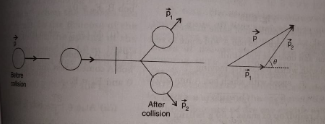A ball of mass m, moving with a speed 2v0 collides inelastically (e>0) with an identical ball at rest. Show that for head-on collision, both the balls move forward.
 Solution in Punjabi
Solution in Punjabi
Step by step video & image solution for A ball of mass m, moving with a speed 2v_0 collides inelastically (e>0) with an identical ball at rest. Show that for head-on collision, both the balls move forward. by Physics experts to help you in doubts & scoring excellent marks in Class 11 exams.
Updated on:21/07/2023Topper's Solved these Questions
Similar Questions
Can mechanical waves travel through vacuum?
View SolutionA ball of mass m moving at a speed v makes a head on inelastic collision with an identical ball at rest. The kinetic energy of the balls after the collision is 3/4th of the original. Find the coefficient of restitution.
View SolutionA billiard ball moving with a speed of 5 m//s collides with an identical ball, originally at rest. If the first ball stop dead after collision, then the second ball will move forward with a speed of:
View SolutionA ball of mass m m , moving with a speed 2upsilon_(0) , collides inelasticaly (egt0) with an identical ball at rest. Show that (a) For head - on collision, both the balls move forward. (b) For a genergcollision, the angle between the two velocities of scattered balls is less that 90^(@) .
View SolutionA ball of mass m moving with a speed 2v0 collides head-on with an identical ball at rest. If e is the coefficient of restitution, then what will be the ratio of velocity of two balls after collision?
View SolutionA ball of mass M moving with speed v collides perfectly inelastically with another ball of mass m at rest. The magnitude of impulse imparted to the first ball is
View SolutionA ball moving with speed u collides with an identical ball at rest. The velocities of two balls after collision are (If the collision is elastic):
View SolutionA ball of mass mm, moving with a speed 2υ0, collides inelasticaly (e>0) with an identical ball at rest. Show that (a) For head - on collision, both the balls move forward.
(b) For a genergcollision, the angle between the two velocities of scattered balls is less that 90∘.
View SolutionA ball of mass m , moving with a speed 2v_(0) collides inelastically ( e gt 0) with an identical ball at rest . Show that (a) For head - on collision , both the balls move forward . (b) For a general collision , the angle between the two velocities of scattered balls is less than 90^(@)
View SolutionA ball of mass m moving with a speed 2v0 collides head-on with an identical ball at rest. If e is the coefficient of restitution, then what will be the ratio of velocity of two balls after collision?
View SolutionA ball of mass m moving with a speed 2v_0 collides head-on with an identical ball at rest. If e is the coefficient of restitution, then what will be the ratio of velocity of two balls after collision?
View SolutionA billiard ball moving with a speed of 5m/s collides with an identical ball, originally at rest. If the first ball stop dead after collision, then the second ball will move forward with a speed of:
View Solutionm द्रव्यमान की 2v0 वेग से चलती हुई एक गेंद विरामावस्था में रखी हुई एक अन्य सर्वसम गेंद से अप्रत्यास्थ (e > 0) रूप से टकराती है। दर्शाइए कि,
(a) सम्मुख संघट्ट होने पर दोनों गेंदें आगे चलेंगी।
(b) सामान्य संघट्ट में, संघट्ट के पश्चात् प्रकीर्णित गेंदों के वेगों के बीच कोण 90∘ से कम होगा।
View SolutionA ball of mass m moving at a speed v makes a head on inelastic collision with an identical ball at rest. The kinetic energy of the balls after the collision is 3/4th of the original. Find the coefficient of restitution.
View SolutionA ball of mass M moving with speed v collides perfectly inelastically with another ball of mass m at rest. The magnitude of impulse imparted to the first ball is
View SolutionA ball of mass M moving with speed v collides perfectly inelastically with another ball of mass m at rest. The magnitude of impulse imparted to the first ball is
View Solution
